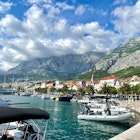

Keep these helpful tips in mind when planning the best time to visit Dubrovnik © FG Trade / Getty Images
Dubrovnik has withstood earthquakes and sieges. Its marble flagstones and rugged walls give this lovely city – Croatia’s most popular – a timeless feel.
- placement: fullWidth
- path: articles/in-content-top
- possible size: [970, 250], [970, 90], [728, 90], [300, 250], [320, 50], [1, 1],
- targeting:
{ "url": "best-time-to-visit-dubrovnik", "destination": "Dubrovnik", "continent": "Europe", "country": "Croatia", "city": "Dubrovnik" }
But the seasons vary hugely in Dubrovnik. Choosing the best time to visit depends on your attitude to the weather and the crowds. High summer can mean festivals and sun, while winter can seem like you have the city to yourself. Here's the best time to visit Dubrovnik.
What’s the weather like in Dubrovnik?
Dubrovnik is in southern Dalmatia, near Croatia’s southern tip. The Adriatic offers swimming and water sports and gives this port city a maritime climate. Summers are warm and sunny, and winters are damp and fairly mild. It’s a compact place, with under 50,000 residents – making it significantly smaller than Split and Zadar further up the coast. That means the picturesque old town can get crowded, so plan your trip carefully.

Busy July and August are best for good weather and great festivals
In July and August (the high season), the sea is warm, and there’s an average of 11 hours of sunshine each day. Temperatures frequently exceed 95°F (35°C) as a constant stream of festivals – which focus on classical music, theater, folk and opera – arrive in town. Croatia’s many dance music festivals are further up the coast near Zadar, but buses and ferries make getting around a breeze.
This all means Dubrovnik gets busy, so arrange accommodations as early as possible. Overnight visitors are joined by cruise ship passengers several times a day, which can make the old town hectic. Things are quietest before 9.30am or after 3pm, and day trips and visits to nearby islands mean you won’t struggle to fill your day.
- placement: fullWidth
- path: articles/in-content-middle
- possible size: [970, 250], [970, 90], [728, 90], [300, 250], [320, 50], [1, 1],
- targeting:
{ "url": "best-time-to-visit-dubrovnik", "destination": "Dubrovnik", "continent": "Europe", "country": "Croatia", "city": "Dubrovnik" }
By August, the water is at its warmest, though you may need to look for longer to find a quiet spot – try hopping on a sea kayak or getting a boat to the car-free Elaphite Islands. Dubrovnik’s cultural blitz continues with concerts and theater (usually including 16th-century playwright Marin Držić’s exuberant comedies). The heat and high visitor numbers mean it’s not worth rushing – instead, go with the flow and soak up the atmosphere.

There are fewer crowds in May and June, plus September and October
In May, June, September and October, temperatures of 77°F (25°C) or higher are common, and while the sea can be cool, this is still a good time for a beach-focused holiday. The old town can still be crowded but without the intensity of July and August. Conditions are good for touring the islands, hiking or rafting.
May is a great time to visit as almost everything is open without being too busy. You can breathe in the spring from pavement cafes, and it’s a good month for walking (try the Way of the Cross, hilly Šipan, or wooded Mljet). June offers warm sun and an early summer buzz, plus you’ll find less congestion on the city’s famous walls, giving you more time to appreciate Dubrovnik’s proud trading history and glittering sea views.
By September, Dubrovnik slips gently into the shoulder season. At the start of the month, classical festivals are still in full swing, the weather can be baking, and the old town is full of eager visitors. But as September moves on, things become cooler and less feverish. It’s a fine time to visit, with plenty of sunshine but less museum neck-craning.
- placement: native
- path: articles/in-content-native
- possible size: [f, l],
- targeting:
{ "url": "best-time-to-visit-dubrovnik", "destination": "Dubrovnik", "continent": "Europe", "country": "Croatia", "city": "Dubrovnik" }
October is another of Dubrovnik’s most pleasant months and your last chance for beach time. Some restaurants and hotels shut, but there’s enough going on for the city to still feel vibrant, including food festivals and sporting events. Hiking and kayaking are appealing, accommodations are relatively affordable, and the cool waters off beaches such as Sveti Jakov and Bellevue are yours to explore.

The low season (November to April) is great for cheap deals
Visit between November and April, and you can forget the beach. But if you’re looking to explore the city’s architectural and cultural delights in peace, you’re in luck. The old town feels less like a busy museum and more like a living city, quite a few bars and restaurants stay open right through the winter, and hotel prices drop substantially.
November can be lovely, with average temperatures reaching a high of around 62°F (17°C). You’ll rarely wait in line anywhere, so you can pack in museums, galleries, churches, and nearby destinations such as Split before heading inside to fill up on the hearty likes of stuffed peppers and fažol (spicy bean soup). December is usually cold and often wet, but celebrations bring a spark to its dark evenings. The Winter Festival has twinkling lights, a Christmas Fair, and plenty of cod dishes.
Most visitors stay away for January, the city’s coldest month. But come February, the festivals begin again. The Feast of St Blaise celebrates Dubrovnik’s patron saint with concerts and theater, while the Carnival packs in a costume parade, wine, street food, and kids’ activities. Visitor numbers are still low in March, but it’s good for exploring the city walls or day trips to fishing villages or Trsteno Arboretum. Accommodations are still inexpensive.
April sees a distinct uptick in sunshine and a shift in the city’s energy too. Easter is the traditional start of the tourist season, and the festival features street events and pinca sirnica, a sweet Easter bread.
- placement: fullWidth
- path: articles/bottom
- possible size: [970, 250], [970, 90], [728, 90], [300, 250], [320, 50], [1, 1],
- targeting:
{ "url": "best-time-to-visit-dubrovnik", "destination": "Dubrovnik", "continent": "Europe", "country": "Croatia", "city": "Dubrovnik" }
Explore related stories

Tips & Advice
Montenegro vs Albania: how to choose between two Balkan beachfront countriesOct 4, 2024 • 7 min read



 Local VoicesItaly vs Croatia: which Mediterranean country is right for you?
Local VoicesItaly vs Croatia: which Mediterranean country is right for you?Jun 13, 2024 • 8 min read



 Destination Practicalities18 things you need to know before visiting Croatia
Destination Practicalities18 things you need to know before visiting CroatiaMar 17, 2024 • 6 min read
 BeachesCastles, cities, coastlines and more: the 16 best places to visit in Croatia for 2024
BeachesCastles, cities, coastlines and more: the 16 best places to visit in Croatia for 2024Mar 2, 2024 • 8 min read

